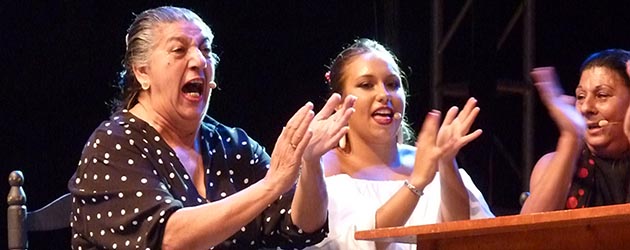Text and photos: Estela Zatania
August 24-26, 2017. 10:00pm. Patio de San Fernando, Alcázar, Jerez de la Frontera
…and Jerez threw itself a party
Thursday 24. “BODAS DE ORO”. Artistic and musical director: Pedro Garrido “Niño de la Fragua”. Male voices: José Montoya “El Berenjeno”, Manuel de Cantarote, Ezequiel Benítez, Manuel de la Fragua, Perico “El Pañero”, Rubio de Pruna, Pedro Garrido “Niño de la Fragua”. Female voices: Felipa del Moreno, Lela Soto, Carmen Grilo. Dance: Saray García, Rocío Marín. Guitars: Juan Manuel Moneo, Nono Jero, Joselito de Pura. Palmas: Juan Diego Valencia, Tarote, José Rubichi. Percussion: Carlos Merino. Friday
25. “JEREZ, CAI Y LOS PUERTOS A CAMARÓN”. Music director: Diego Magallanes. Voice: José Gálvez, Davinia Jaén, Ángel Pastor, Niño del Parque, Selu del Puerto, Nazaret Cala, Raúl Gálvez, Carmen de la Jara. Dance: David Nieto, Macarena Ramírez. Guitars: Víctor Rosa, Niño de la Leo. Musicians: Electric bass, Faluky Gómez. Sax and flute, Carmelo Muriel. Violín, Nerea Gómez. Chelo, May Asunción. Piano, Sergio Monroy. Accordion, Diego Magallanes. Drums, Juan Sainz.
Saturday 26. “LA TIERRA Y EL CANTE”. Artistic and musical director: Pepe del Morao. Executive producer: Juan Alfonso Romero. Voice: Juana la del Pipa, María Terremoto, Dolores Agujetas, Luis Moneo, Antonio Malena, José El Mijita. Guitar: Manuel Parrilla, Diego del Morao, Pepe del Morao. Violin: Bernardo Parrilla. Dance: María del Mar Moreno, Joaquín Grilo. Rhythm and percussion: Ané Carrasco, Juan Diego Valencia, Alejandro.
Jerez de la Frontera and its flamenco straddle a world that is both traditional and cliché. The wooden table to receive the rhythm marked by knuckles, the threshing scene that recreates a past that is as innocent as it is painful and let’s not forget the blacksmith forge. Jerez has a wealth of treasured local customs, and a flamenco mental state as well as profoundly communicative art. Juan de la Plata, director of the Cátedra de Flamenco, knew this fifty years ago when he had the idea to establish the Fiesta de la Bulería, and we were able to share the mega fiesta offered over three days by more than 60 artists.
Fifty years. Other flamenco events have reached the same benchmark, but when it comes to the Fiesta de la Bulería of Jerez de la Frontera, it somehow feels like the representation of a half-century of the flamenco genre. From the death throes of the musical revues of the 1960s that would include flamenco, to the unrelenting sobriety of Antonio Mairena who disapproved of rumba and fandangos being included in the festivals where he was influential, it’s been a long journey in which Jerez has always been leading the way.
From the 21st to the 25th inclusive, there were various parallel activities, such as a bulerías flash-mob, or the unveiling of a commemorative plaque at the birthplace of the legendary singer, Juanito Mojama (1892-1957)
On Thursday the 24th, young singer Pedro Garrido, “Niño de la Fragua”, took on the difficult task of representing the 50 years of evolution since the birth of this event. In the first part, the metaphor of a train was employed to virtually travel through the various flamenco areas via noteworthy interpreters such as Agujetas, Chocolate, Fosforito, Antonio Mairena, Lebrijano, Fernanda de Utrera, el Borrico, Sordera, el Chozas, Paquera, Terremoto de Jerez, Sernita, Chano Lobato and la Perla, or dancer Manuela Carrasco, all of whom were evoked by current artists.
In the second part, the recording “Canta Jerez”, considered the Holy Grail of cante in Jerez, was honored for the half-century since its release in 1967. The scene of the recording was loosely reconstructed, and some of the associated artists were recalled through current interpreters such as Pedro and Manuel de la Fragua, Perico Pañero, Rubio de Pruna, Carmen Grilo, Lela Soto, Ezequiel Benítez, Felipa del Moreno and Saray García among others.
Friday the 25th was the most sedate of the three days, with a program dedicated to the memory of Camarón on the 25th anniversary of his passing. After a blast of instrumental flamenco pop to recall that facet of the singer from La Isla, a series of artists performed, the most interesting, perhaps, being that of Carmen de la Jara who sang what she called “tangos variados”, and her “bulerías of the three mothers” in which she recreated verses sung by the mother of Camarón, of la Perla and of Santiago Donday…delightful. Also noteworthy was guitarist Juani de la Isla with his crisp powerful style.
The relatively discreet first and second days were amply compensated by the event’s final program. Classic flamenco, as fresh as a glass of Tío Pepe sherry, from some of the best interpreters of the moment. It would be impossible to cite each one, but noteworthy were Dolores Agujetas, Joaquín Grilo and María del Mar Moreno in dance, and especially young María Terremoto whose rise has been nothing less than meteoric, and who seduced the entire audience with her personality and communicative power.
